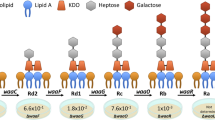Summary
T-even type phages recognize their cellular receptors with the tip of their long tail fibres. The gene products involved in receptor recognition are proteins 37 and 38. While screening libraries of phage K3 with a probe of gene38 from phage T2, a class of weakly hybridizing clones was found in addition to the expected clones of gene38 of K3. One of these clones was identified as being from gene23 of the phage which codes for the major head subunit; another clone originated from gene34, which codes for the proximal half of the long tail fibres. Neither gene product 23 nor 34 is involved in receptor recognition. Phages can recombine with the DNA of the gene23 and gene34 clones and change the host range.
Similar content being viewed by others
References
Beckendorf SK, Kim JS, Lielausis I (1973) Structure of bacteriophage T4 genes37 and38. J Mol Biol 73:17–35
Howley PM, Israel MA, Law MF, Martin MA (1979) A rapid method for detecting and mapping homology between heterologous DNA. J Biol Chem 254: 4876–4883
Maniatis T, Fritsch EF, Sambrook J (1982) Molecular cloning, a laboratory manual. Cold Spring Harbor, Laboratory Press, New York
Manning PA, Puspurs A, Reeves P (1976) Outer membrane ofEscherichia coli K12: Isolation of mutants with altered protein 3A by using host range mutants of bacteriophage K3. J Bacteriol 127:1080–1084
McConaughy BL, Laird CD, McCarthy BJ (1969) Nucleic acid reassociation in formamide. Biochemistry 8: 3289–3295
Morona R, Klose M, Henning U (1984)Escherichia coli K12 outer membrane protein (OmpA) as a bacteriophage receptor: Analysis of mutant genes expressing altered proteins. J Bacteriol 159:570–578
Parker ML, Christensen AC, Boosman A, Stockard J, Young ET, Doermann AH (1984) Nucleotide sequence of bacteriophage T4 gene23 and the amino acid sequence of its product. J Mol Biol 180: 399–416
Riede I, Eschbach ML, Henning U (1984) DNA sequence heterogeneity in the genes of T-even typeEscherichia coli phages encoding the receptor recognizing protein of the long tail fibers. Mol Gen Genet 195:144–152
Riede I, Degen M, Henning U (1985a) The receptor specificity of bacteriophages can be determined by a tail fiber modifying protein. EMBO J 4:2343–2346
Riede I, Drexler K, Eschbach ML (1985b) The nucleotide sequences of the tail fiber gene 36 of bacteriophage T2 and of genes 36 of the T-even typeEscherichia coli phages K3 and Ox2. Nucleic Acids Res 13:605–616
Riede I, Eschbach ML, Henning U (1985c) Presence of DNA, encoding parts of bacteriophage tail fiber genes, in the chromosome ofEscherichia coli K12. J Bacteriol 163:832–836
Riede I, Drexler K, Eschbach M-L, Henning U (1986) DNA sequence of the tail fiber genes37, encoding the receptor recognizing part of the fiber, of bacteriophages T2 and K3. J Mol Biol (in press)
Rüther U, Koenen M, Otto K, Müller-Hill B (1981) pUR222, a vector for cloning and rapid chemical sequencing of DNA. Nucleic Acids Res 9:4087–4098
Sanger F, Nicklen S, Coulson AR (1977) DNA sequencing with chain terminating inhibitors. Proc Natl Acad Sci USA 74:5463–5467
Skurray RA, Hancock REW, Reeves P (1974) Con− mutants: class of mutants inEscherichia coli K-12 lacking a major cell wall protein and defective in conjugation and adsorption of a bacteriophage. J Bacteriol 119:726–735
Vieira J, Messing J (1982) The pUC plasmids, an M13 mp7-derived system for insertion mutagenesis and sequencing with synthetic universal primers. Gene 19:259–260
Wahl GM, Stern M, Stark GR (1979) Efficient transfer of large DNA fragments from agarose gels to diazobenzyloxymethyl paper and rapid hybridization by using dextran sulfate. Proc Natl Acad Sci USA 76:3683–3687
Watt VM, Ingles CJ, Urdea MS, Rutter WJ (1985) Homology requirements for recombination inEscherichia coli. Proc Natl Acad Sci USA 82:4768–4772
Wood WB, Revel HR (1976) The genome of bacteriophage T4. Bacteriol Rev 40:847–868
Yanisch-Perron Y, Vieira J, Messing J (1985) Improved M13 phage cloning vectors and host strains: nucleotide sequences of the M13 mp18 and pUC19 vectors. Gene 33:103–119
Author information
Authors and Affiliations
Additional information
Communicated by P. Starlinger
This paper is dedicated to Prof. Dr. Wolfgang Beermann, Tübingen, on the occation of his 65th birthday
Rights and permissions
About this article
Cite this article
Riede, I. T-even type phages can change their host range by recombination with gene34 (tail fibre) or gene23 (head). Molec. Gen. Genet. 205, 160–163 (1986). https://doi.org/10.1007/BF02428046
Received:
Issue Date:
DOI: https://doi.org/10.1007/BF02428046




